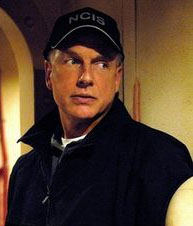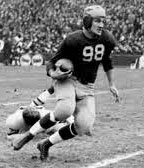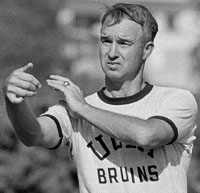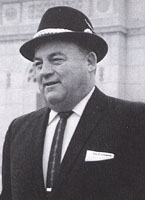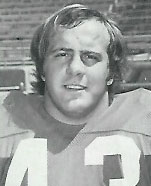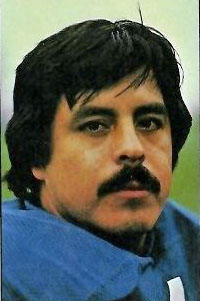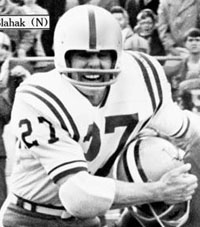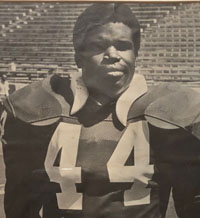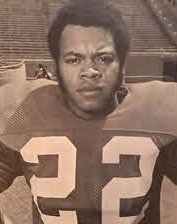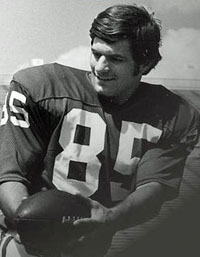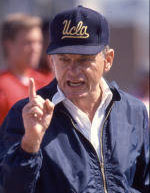|
Mark Harmon certainly had a huge legacy to live up when he decided to play football. His parents were Tom Harmon, the 1940 Heisman Trophy winning RB from Michigan, and actress Elyse Knox. Growing up in Southern California, Mark took his football talents to Pierce Junior College in Los Angeles before transferring to UCLA for his junior year. He won the starting quarterback job to lead the new wishbone offense installed by Coach Pepper Rodgers for the 1972 season.
The Bruins, overshadowed the previous decade by their crosstown rival, USC, were coming off a 2-7-1 season in Rodgers' first year. And what a daunting challenge to open the new campaign. Bob Devaney's two-time defending national champion Nebraska Cornhuskers, riding a 32-game unbeaten streak, were the preseason #1 as they came to the Los Angeles Coliseum for the Saturday night opener. UCLA was a 15-point underdog, but they had a major factor in their favor - their new wishbone attack run by a new quarterback with the assistance of new RB James McAlister, a highly touted recruit who had missed the 1971 season because he was academically ineligible. So you'd expect the Bruins to start strong, but the UN Blackshirts defense to adjust to it by halftime. On the other side of the ball, UCLA had only one defensive starter returning from '71. So even if the Bruins scored some points with their new offense, their chances of holding down the mighty Cornhusker attack was slim and none. They would need the UN offense to stop itself with turnovers, and that's exactly what happened. Rodgers approached the new season with a quiet confidence. He privately predicted that his young team might surprise some teams - even Nebraska.
A crowd of 67,702 in the Los Angeles Coliseum saw one of the biggest upsets in college football history. Tom Harmon went into broadcasting after his playing career ended. He did the play-by-play for UCLA starting in the 1960s. So he announced his son's games during Mark's two-year stint as a Bruin.
First QuarterNebraska got the ball to start the game and drove 37y in nine plays to set up a 45y FG attempt by Rich Sanger that fell a few inches short of the crossbar. UCLA took over at their 28 and immediately introduced McAlister to the college football world. He exploded for 35y into UN territory on his first carry. But the drive stalled; so Mexican-born soccer-style kicker Efren Herrera tried a 42y FG only to have CB Joe Blahak block the kick, giving the Huskers the ball at their own 37. On the next play, FB Bill Olds fumbled and DE Cal Peterson recovered for UCLA on the UN 35. The Bruins didn't move far but it was enough for Herrera to kick a 27y FG. UCLA 3 Nebraska 0 (4:26) 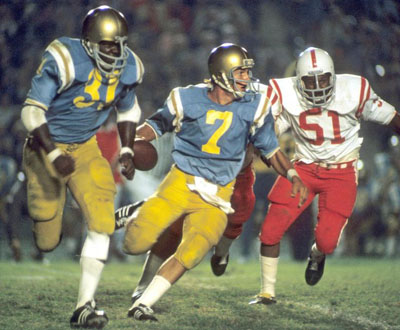 Mark Harmon looks for opening Second Quarter 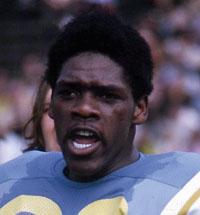 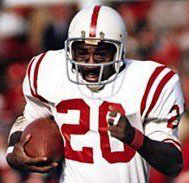 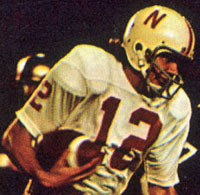 L-R: James McAlister, Johnny Rodgers, David Humm Another Nebraska turnover gave the home team an excellent chance to retake the lead. Sophomore QB David Humm overthrew Rodgers, the ball landing in the hands of CB Jimmy Allen, who returned the interception 37y to the UN 15. It took five plays but the Bruins converted the break into a touchdown when Harmon took it over from the two. UCLA 17 Nebraska 10 (7:21) The Huskers' turnover woes continued on their next possession. Dixon lost his second fumble when he ran into one of his offensive linemen at the UN 33. However, the Blackshirts forced a 33y Herrera FG try that went awry. Starting from their 20, Nebraska unleashed their longest drive of the evening, driving 53y in 12 plays to the 27. Just when it seemed inevitable that the favorites would tie the game, Allen picked off Humm again, this time at the 10. End of Q3: UCLA 17 Nebraska 10 Fourth Quarter Post Game Homer Smith, UCLA's offensive coordinator who was tasked with installing the wishbone, was pleased with Harmon's commitment to the system. "Mark had been so eager about learning the wishbone," Homer recalled, "and had worked so hard that I was really gratified he did so well after all the investment he had made."
Bruin RB Kermit Johnson joined in the praise. "I gained a lot of respect for Mark. If you look back, Mark had to take some helluva shots for that wishbone to work right. He ran the wishbone just like no other quarterback has run it. There were times he took shots just to draw defenders to him to eliminate them and then pitched the ball." UCLA finished the 1972 season with an 8-3 record, good enough for a #15 ranking in the final Associated Press poll. Nebraska went 9-2-1 to earn the #4 slot.
|
|
